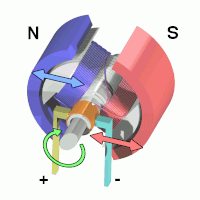
Photo from wikipedia
Abstract In high frequency (HF) injection methods, classical tracking algorithms are used to estimate the rotor position for sensorless alternating current (AC) salient pole machines. These algorithms were dependent on… Click to show full abstract
Abstract In high frequency (HF) injection methods, classical tracking algorithms are used to estimate the rotor position for sensorless alternating current (AC) salient pole machines. These algorithms were dependent on AC machine inductances which are characterized by their large variations. To overcome this dependency, a new approach based on using only the sign of the rotor position estimation error (instead of using rotor position estimation error) is proposed. This approach has also the advantage of removing the low-pass filter (LPF) used to separate the HF component from the rotor position information. Consequently, only the first order sliding mode observer can be employed to estimate the rotor position, as only the sign of the rotor position estimation error is known. To avoid the well known chattering phenomena of this observer, an adaptive step-by-step sliding mode observer is proposed as an alternative solution to estimate the rotor position of the machine. The stability study of the proposed observer is analyzed both in transient/steady state ranges and a procedure for gains tuning is then given. The performance of the proposed algorithm is tested on simulation and experimentally in the framework of a representative small-scale electric propulsion benchmark, used in automotive applications. Moreover, a comparison study is conducted with respect to some existing tracking algorithms in order to illustrate the well-founded of the designed algorithm.
Journal Title: Control Engineering Practice
Year Published: 2019
Link to full text (if available)
Share on Social Media: Sign Up to like & get
recommendations!